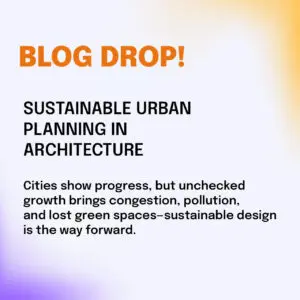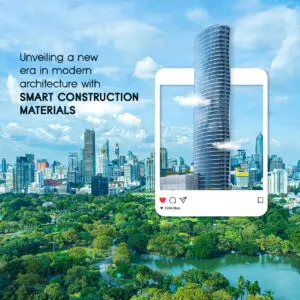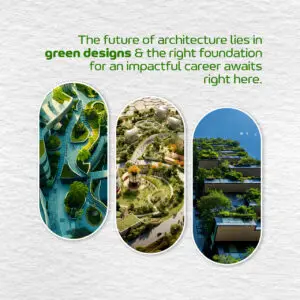
Modern rural and urban infrastructure is powered by a seamless coordination between Architecture and Civil Engineering. These two disciplines, often viewed in isolation, are now intricately connected and work together to transform bold visions into concrete realities.
Architecture infuses projects with creativity, human-centric design, and visual identity, while civil engineering brings structural integrity, technical precision, and long-term sustainability. From towering river dams that control vast water systems to mighty bridges that connect regions, from expansive highways and skywalks that redefine urban mobility to flyovers that ease traffic in densely populated cities — every modern marvel is a result of this potent blend.
Consider the cutting-edge design of airports, the architectural elegance of ports, or the precision behind superfast train networks; each stands as a testament to how these two fields are collectively shaping the future landscapes.
Design Meets Durability: How Aesthetic Vision is Engineered into Reality
Behind every striking structure lies a story of creativity combining scientific expertise through architecture and civil engineering.
While architects envision the form, functionality, and experience of a space, civil engineers work to ensure that this vision can stand the test of time, weather, and load. The planning phase often begins with both teams working in tandem, balancing the beauty of a curved façade with the physics of load distribution or integrating natural light while maintaining thermal efficiency.
Materials are chosen for appearance, strength, sustainability, and site-specific factors like soil type or seismic zones. Take the Burj Khalifa, for example. Architects conceived its iconic tapering design, but its realisation demanded advanced structural engineering, including high-performance concrete and a hexagonal core to ensure stability against wind forces.
Whether sculpting a cultural museum or erecting a high-speed rail terminal, the seamless integration of design and durability ensures that aesthetic ambition is never compromised by structural reality.
Sustainable Structures: A Blueprint by Architecture and Civil Engineering
As the demand for smart, connected, and eco-conscious urban environments grows, infrastructure development has accelerated like never before.
From energy-efficient high-rises and climate-responsive metro stations to intelligently networked bridges and green-certified airports, tomorrow’s landscape is being built at a remarkable speed. This rapid progress begins long before construction, with architects and civil engineers co-developing detailed blueprints that blend design innovation with functional excellence.
Digital tools like Building Information Modelling (BIM) allow teams to simulate energy usage, optimise space, and pre-empt structural challenges before the first stone is laid. Sustainability is embedded at every level, from using recycled materials and solar panels to designing natural ventilation systems and smart water management. For example, the Hyderabad Metro Rail, one of India’s most advanced transit systems, was designed sustainably, featuring solar-powered stations and minimal land disruption.
Architecture and civil engineering unite to shape every resilient, advanced project across the globe, turning urban dreams into resilient, future-ready realities.
From Sketch to Skyline: The Workflow of Integrated Project Delivery
Creating iconic structures, be it a gravity-defying skyscraper, a sprawling airport, or an intricately designed cultural centre, demands a workflow where architecture and civil engineering collaborate seamlessly at every phase.
This process, known as Integrated Project Delivery (IPD), ensures that every handoff, from creative sketching to final construction, is coordinated, cost-efficient, and technically sound.
As the design evolves, both disciplines use advanced tools like BIM to simulate, revise, and perfect every detail — from structural load paths to HVAC systems.
Conceptualisation & Visioning
↓ (Architecture-led with engineering consultation)
Feasibility Analysis & Site Study
↓ (Engineering-led with architectural input)
Schematic Design Development
↓ (Joint effort – Architects shape form; Engineers ensure feasibility)
Detailed Design & Simulation (BIM Integration)
↓ (Equal collaboration – Structural, MEP, and aesthetic detailing)
Material Selection & Budgeting
↓ (Engineering-led with architectural coordination)
Construction Planning & Scheduling
↓ (Engineering-led; architectural supervision for design fidelity)
Execution & Construction
↓ (Engineering-driven; architects oversee design integrity)
Quality Checks, Sustainability Audits & Handover
↓ (Joint responsibility – Engineers for compliance; Architects for finish and design)
Post-Construction Evaluation & Maintenance Planning
(Engineering-led; architectural input for long-term space use)
Blending the Best of Both Worlds: OmDayal Group of Institutions
The philosophy that prepares students at OmDayal Group of Institutions enables them to think holistically, collaborate effectively, and build responsibly. Our architecture and civil engineering courses (see our scholarship schemes) are more than just academic, fostering an environment where design innovation meets engineering precision. We prepare the students with skills to shape skylines, solve real-world challenges, and contribute meaningfully to the built environment.
Reference:




